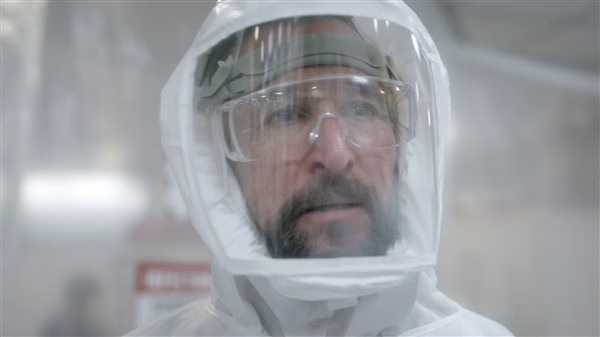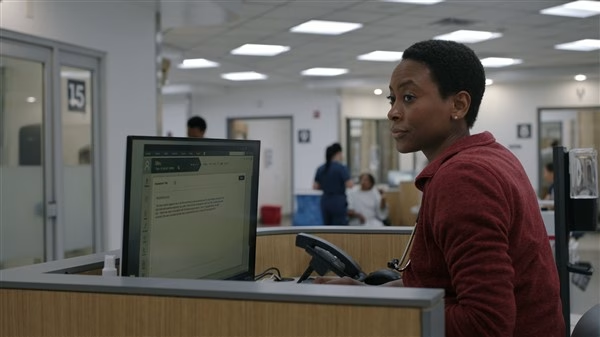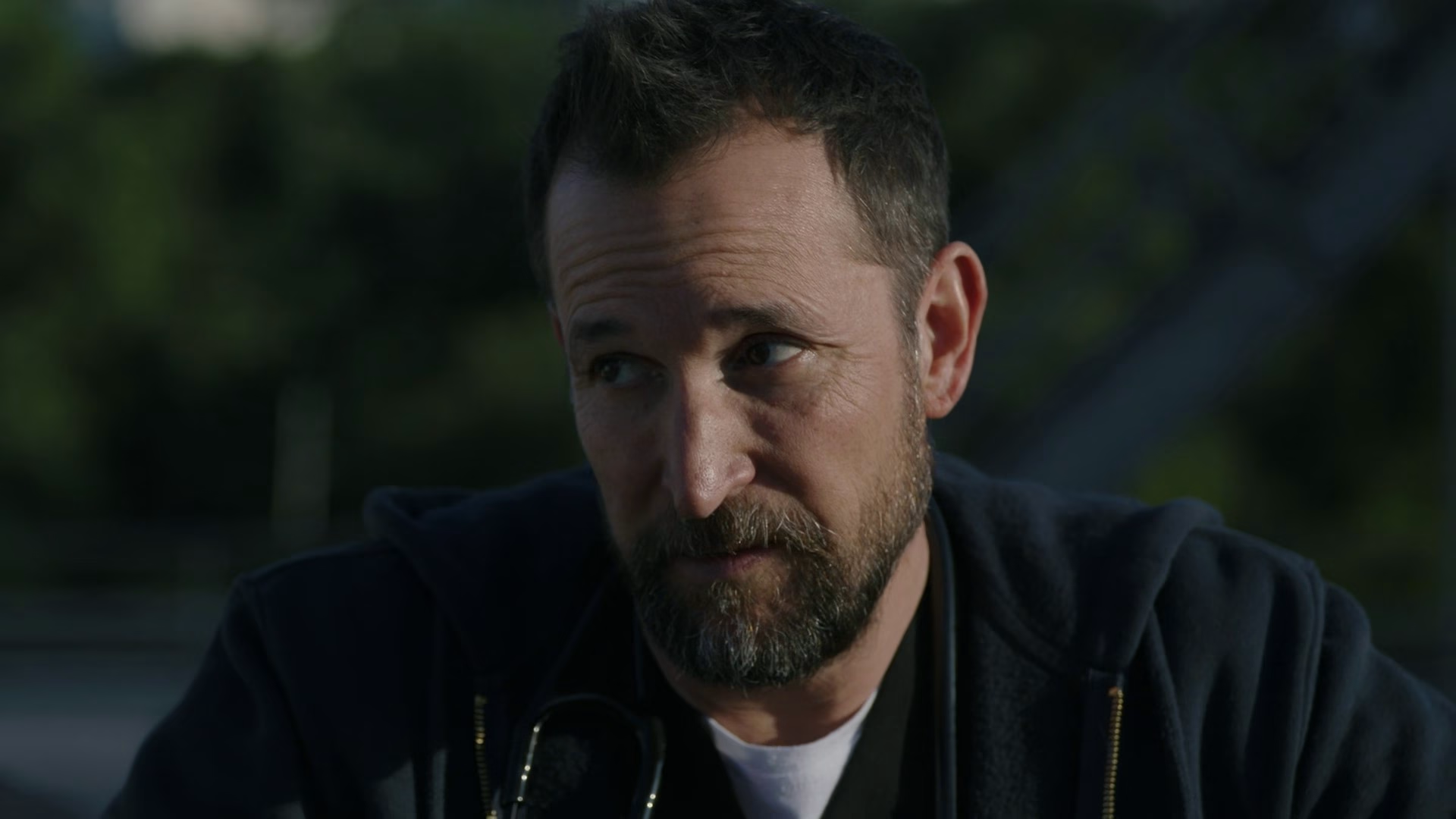The Pitt “7:00AM” & “8:00AM”
Created and written by R. Scott Gemmill
Directed by John Wells (“7:00 A.M.”), Amanda Marsalis (“8:00 A.M.”)
New episodes premiere Thursdays on Max
It would be easy to call The Pitt, Max’s high-profile medical drama, just a simple mash of ER and 24; set in a Pittsburgh hospital emergency room, each episode of The Pitt depicts a real-time hour in the lives of its doctors, nurses, staff and patients. Starring former ER star Noah Wylie, with a pilot directed by original ER showrunner John Wells and written by longtime ER writer R. Scott Gemmill, it seems obvious the series would aim to be a realistic, relevant drama about the inner lives and external conflicts of an ensemble cast of hospital employees (and, of course, visitors). Which is exactly what The Pitt is in a lot of ways – it just so happens to also be one of the most focused, driven new shows of the young pilot season, when it’s able to find the delicate balance between narrative, character, and metaphor amongst its impressively-arranged chaos.
What I really appreciate about The Pitt, strangely enough, is how unsuspectingly demanding it is of its audience; while most maudlin modern medical dramas try to bring complexity and tension through a combination of convoluted interpersonal dynamics and shock-inducing medical anomalies, The Pitt‘s opening hours are a distinct return to basics for the genre, where its societal commentary may be superficial and grandiosely expressed, but is distinctly shown through its narrative and characters, leaving room for the audience to interpret and infer (something we once took for granted in quality television that is increasingly lost each year, it feels like). Characters can’t linger on decisions, which allows for a lot of room for inference and reflection on actions taken; The Pitt doesn’t explain these moments to the audience like children either, which help the show build a really strong storytelling rapport with its audience in just the first two episodes, two hours of a TV show telling its audience to buckle the fuck up and pay a little bit of attention.

There are nearly a dozen micro-narratives and emotional arcs introduced in the first two episodes alone; The Pitt‘s ability to weave through them is consistently impressive in its opening hours, which bode well for the show’s ability to build and maintain the occasionally-overwhelming pace of “7:00 A.M.” and “8:00 A.M.” over 13 more episodes, without it all coalescing into an indistinguishable mush of blurry-faced scrubs and forgettable patients. The first two episodes have a lot going on, but carefully construct each scene to be effective and efficient – often by using less dialogue, requiring its cast to actually emote and build resonance through performance rather than delivery (another increasingly annoying trend, especially with network dramas).
This is led by Wylie, of course – who justifies his casting as more than just a cliche with perhaps the finest performance of his career. The Pitt‘s first season is set on the fourth anniversary of Dr. Robby losing his mentor; under the wrong actor, this kind of underlying tension could lead to some really hacky acting, especially as he takes on the role of grizzled, proficient veteran doctor – but he’s really terrific, carrying the age, confidence, and resignation of Dr. Robby with a wisely restrained gravitas. Dr. Robby is very much a Kelley or Sorkin-esque character, a sad man full of regrets trying to push all his pain and conflict into the lines aging his face, pushing forward against every depressing, challenging tide wading over him.
His performance sets a grounded tone for The Pitt; and for the most part, I love what this series does to revitalize what I still consider a vital part of a thriving television genre (though we certainly need more series like this, than we do along the vein of Doc). The Pitt doesn’t bullshit, with its depiction of medicine or its characters; though this sometimes leads the series into some rather stilted reflections on the world we live in, its ability to ground those in an incredibly wide swath of characters gives it an incredible amount of storytelling diversity, which it smartly and carefully dispenses at various moments throughout the first two episodes.

That’s not to say it’s perfectly calibrated; sometimes, it’s incredibly focused cinematography betrays the show’s somewhat limited attempt to give its stories full dimensionality (some of them are very much gaudy “case of the hour” material like a kid who accidentally eats pot gummies; but is that not the bedrock of good medical drama?). But where its creativity is occasionally limited in construction, the force and consistency of its delivery helps smooth some of those rougher, more dissonant edges; it’s also a series that never takes a moment to stop, which keeps it from ever lingering on an underdeveloped moment or character, as its eyes are always squarely focused on economy of message and expression. The Pitt is a series with serious momentum; its relative lack of quiet moments is clearly intentional, building an anxious, instinct-driven sense of storytelling with a cascade of overlapping patient stories, character interactions, and underlying tensions, a few of which are already boiling to the surface with a few interesting characters.
Over the course of 15 hours, of course, some of this may just be hard to maintain without feeling a bit sanctimonious or melodramatic; but a degree of that is to be expected with such traditional storytelling priorities, especially those with a penchant for a bit of social commentary on what’s become a fundamentally broken system in America (an upcoming episode features a teenager from Tennessee trying to get an abortion, for example). But despite the sheer weight and number of stories and personalities, The Pitt never feels weighed down or underdeveloped; at least in its first two episodes, there’s an incredibly impressive clockwork mechanism delivering and funneling story and character from scene to scene, in what makes for really anxious, draining – and fundamentally watchable television.

I’m looking forward to seeing where The Pitt takes its cast – which includes a huge list of impressive performances, including Fiona Dourif, Katherine LaNasa, Tracy Ifeachor, and Gerran Howell across a diversity of hospital personalities (unsurprisingly, The Pitt‘s pilot utilizes a med school class’s first day as a device to somewhat ease us into the flow). Again, The Pitt doesn’t reinvent the wheel with its characters; but within its archetypes are sharply-delivered performances, and a clear understanding of how to integrate patient stories in a way that make its characters – and audience – tick, which is what makes The Pitt such a compelling (and occasionally claustrophobic) watch.
Can The Pitt maintain all this plate-spinning for 13 more hours and stick the landing? The answer, obviously, is probably not perfectly; but in a way, that is what could make this show such an enjoyable watch for the first three-plus months of 2025. The Pitt is a challenging, depressing, occasionally soapy series – but it is also focused, meticulous, and incredibly well performed, a series firmly rooted in its own past, but with plenty of modern elements and sensibilities to keep it moving and relevant in the present. It’s a throwback in a lot of ways; and is good enough at most of them that it’ll certainly keep me watching through the first season.
Grade: B+
Discover more from Processed Media
Subscribe to get the latest posts sent to your email.


